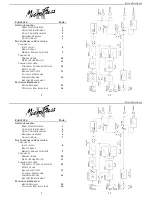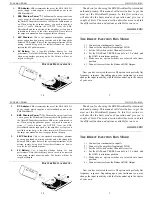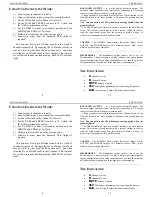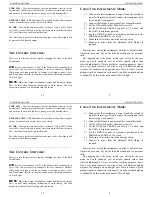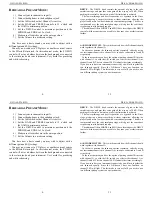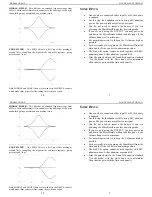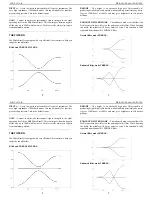
G
ETTING
S
TARTED
D
RIVE
• M
ODE
S
WITCH
6 11
R
EHEARSAL
P
REAMP
M
ODE
:
1) Connect your instrument to input A.
2) Connect headphones to the headphones jack.
3) Set the A/B switch so that Channel A is active.
4) Set the BASS and TREBLE controls to 12 o’clock and
the GAIN to minimum position.
5) Set the DRIVE control to minimum position and the
MIDDLE and EDGE to 12 o’clock.
6) Make sure all switches are in the outer position.
7) Set the Volume to a moderate setting.
You have now a basic sound you may wish to adjust with a
different gain and EQ settings.
You may now connect a CD player or another external source
to the Effects Return jack. In this rehearsal mode, the FX MIX
control will act as a balance between the background as connected
to the return jack and your instrument. Very useful for practicing
and while rehearsing.
DRIVE
– The DRIVE knob controls the amount of gain in the tube
emulation stage, and provides extra gain all the way up to 30 dB. When
pushing this control to distortion, a tube like limitation is achieved
The lower midrange and bass frequencies are bypassed in the Drive
stage, producing a warmer overdrive without saturation, allowing the
player to add more low bass than with conventional preamps. The bass is
compensated over the tube emulation stage, which gives the same bass
response up to mid distorted sounds.
The additional filters MIDDLE and EDGE are located post the DRIVE
control, which means that you are able to fine tune your overdriven tone
further.
__________________________________________________________
A+B MODE SWITCH
– This switch controls how the B channel should
work together with channel A.
In the outer position the channels operate separately, either by using
one instrument connected to channel A, or two ones connected to A and B
respectively.
In the inner position you have the option of putting channel B in series
with channel A, so with the A/B switch you select either channel, A or
channel A and B. The two channel LED’s indicate the status accordingly.
If you however have two instruments connected you will mix together the
two channels equally. Since the A/B doesn’t have any function, no
channel LED will light. This last mode is very useful if you wish to mix
two different pickup systems on one instrument.
G
ETTING
S
TARTED
D
RIVE
• M
ODE
S
WITCH
6 11
R
EHEARSAL
P
REAMP
M
ODE
:
1) Connect your instrument to input A.
2) Connect headphones to the headphones jack.
3) Set the A/B switch so that Channel A is active.
4) Set the BASS and TREBLE controls to 12 o’clock and
the GAIN to minimum position.
5) Set the DRIVE control to minimum position and the
MIDDLE and EDGE to 12 o’clock.
6) Make sure all switches are in the outer position.
7) Set the Volume to a moderate setting.
You have now a basic sound you may wish to adjust with a
different gain and EQ settings.
You may now connect a CD player or another external source
to the Effects Return jack. In this rehearsal mode, the FX MIX
control will act as a balance between the background as connected
to the return jack and your instrument. Very useful for practicing
and while rehearsing.
DRIVE
– The DRIVE knob controls the amount of gain in the tube
emulation stage, and provides extra gain all the way up to 30 dB. When
pushing this control to distortion, a tube like limitation is achieved
The lower midrange and bass frequencies are bypassed in the Drive
stage, producing a warmer overdrive without saturation, allowing the
player to add more low bass than with conventional preamps. The bass is
compensated over the tube emulation stage, which gives the same bass
response up to mid distorted sounds.
The additional filters MIDDLE and EDGE are located post the DRIVE
control, which means that you are able to fine tune your overdriven tone
further.
__________________________________________________________
A+B MODE SWITCH
– This switch controls how the B channel should
work together with channel A.
In the outer position the channels operate separately, either by using
one instrument connected to channel A, or two ones connected to A and B
respectively.
In the inner position you have the option of putting channel B in series
with channel A, so with the A/B switch you select either channel, A or
channel A and B. The two channel LED’s indicate the status accordingly.
If you however have two instruments connected you will mix together the
two channels equally. Since the A/B doesn’t have any function, no
channel LED will light. This last mode is very useful if you wish to mix
two different pickup systems on one instrument.


